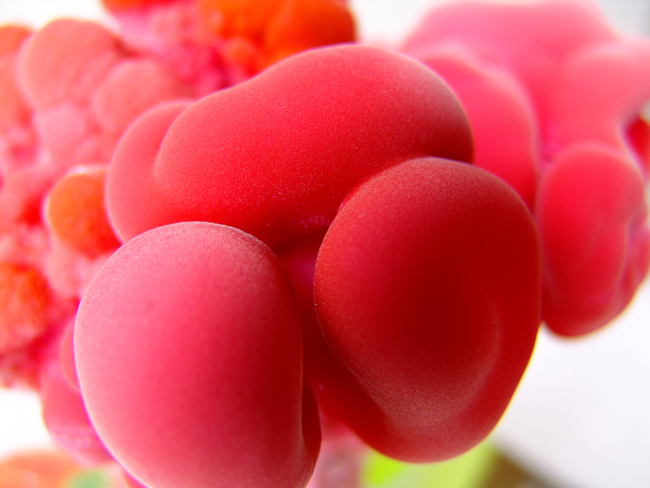
|
Kunstdünger
Kunstdüngerkristallisationen sind ein wichtiger Bestandteil der meisten Installationen. Aus wässrigen Lösungen formieren sich korallenartige Gebilde, Stalaktiten, Nadeln, kugelige Wucherungen, pelzige Krusten - je nach Situation und Klima. Sie wachsen und entwickeln ihre Formen während der ganzen Ausstellungsdauer. Danach werden sie eingesammelt und können in Wasser aufgelöst wieder Ausgangspunkt einer neuen Geschichte werden. Es gibt Kristalle, die können sich an bis zu fünfzehn verschiedene Ausstellungen erinnern. Je öfter sie wachsen, desto gescheiter, schöner und wertvoller werden sie. Der Kunstdünger Harnstoff hat dazu beigetragen, die Grenzen zwischen Künstlichem und Natürlichem aufzulösen. Mitten in der Romantik gelang es 1828 zum ersten Mal, diese organische Substanz künstlich herzustellen. Bis dahin glaubte man, dass nur die geheimnisvolle "Vis vitalis" (Lebenskraft) fähig sei, organische Verbindungen hervorzubringen, und es nicht in der Macht der Menschen läge, diese zu kopieren. Unterdessen wird synthetischer Harnstoff weltweit in Megatonnen auf die ausgelaugten Felder gekarrt, um die Ernten aufzublasen. Zur industriellen Herstellung dieses Düngers benötigt man Luft, Wasser und Erdgas, um danach die daraus erhaltenen Elemente Stickstoff, Wasserstoff, Sauerstoff und Kohlenstoff richtig zu verquicken. Dieser Prozess verbraucht riesige Mengen fossile Energie, welche wir später durch unsere Lebensmittel teilweise wieder aufnehmen. Künstlicher Harnstoff ist auch als Zusatz in Tierfutter, Kosmetika, Klebstoffen und Kaugummis anzutreffen. Der menschliche Körper selbst produziert ebenfalls Harnstoff, als Endprodukt des Eiweissstoffwechsels (das sind täglich circa zwanzig Gramm - ehrgeizige Menschen produzieren etwas mehr). Er bildet sich in der Leber, gelangt über das Blut in die Nieren und wird mit dem Urin ausgeschieden. |
Artificial fertilizer
The crystallisation of artificial fertilizer is an important component in most of the installations. Coral-like figures, stalactites, needles, spherical growths and furry crusts all form from a watery solution, depending on the situation and the climate. The shape of these figures grows and develops throughout the entire duration of the exhibition. Afterwards they are gathered together and can be dissolved in water to create the starting point for a new story. There are crystals that can remember up to fifteen different exhibitions! The more often they grow the more intelligent, beautiful and precious they become. The artificial fertilizer urea has contributed to the dissolution of the boundaries between the artificial and the natural. In 1828, in the middle of the Romantic period, this organic substance was produced artificially for the first time. Until then it was believed that only the mysterious "vis vitalis" (life force) was capable of producing organic compounds, and that it was not within the power of human beings to copy them. Since then, megatonnes of synthetic urea have been carved out onto exhausted fields around the world in order to fatten up the crops. Industrial production of this fertilizer requires air, water and natural gas so that the extracted elements of nitrogen, hydrogen, oxygen and carbon can then be properly combined. This process wastes vast quantities of fossil energy, which we partially reabsorb later through our foodstuffs. Artificial urea is also used as a supplement in animal feed, cosmetics, glue and chewing gum. The human body itself also produces urea as the end product of the metabolism of protein (around 20 grams daily - some ambitious humans produce slightly more). It is produced in the liver, transported in the blood to the kidneys and is then excreted in our urine. |